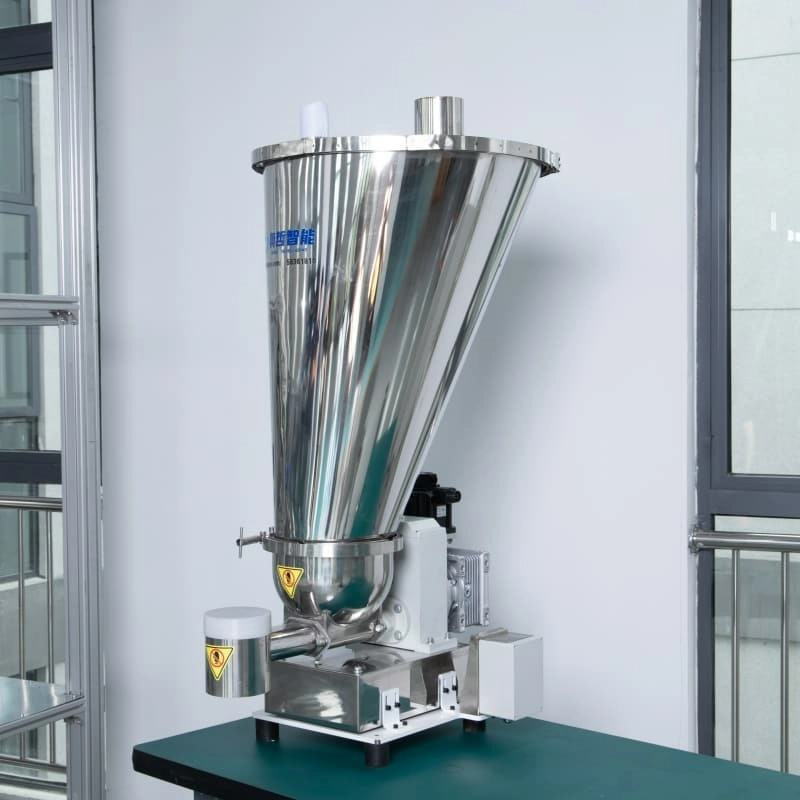تركيب وصيانة وحدة التغذية ذات المسمار الواحد ذات فقدان الوزن: ضمان التشغيل الفعال على المدى الطويل
وقت الإصدار: 2025-06-07
وحدة تغذية المواد ذات المسمار الواحد ذات فقدان الوزن هي وحدة تغذية مواد دقيقة تُستخدم على نطاق واسع في العديد من الصناعات. لضمان عمل هذه المعدات بكفاءة وموثوقية على مر الزمن، يُعد التركيب السليم والصيانة الدورية أمرًا أساسيًا. فيما يلي بعض التوصيات لتركيب وصيانة هذه الوحدة: وحدة تغذية ذات برغي واحد مع فقدان الوزن لضمان استقرارها وكفاءتها على المدى الطويل.

1. تركيب المعدات
التحضير قبل التثبيت
اختيار موقع التركيب المناسب: تأكد من تركيب وحدة التغذية على سطح مستوٍ بعيدًا عن مصادر التداخل الكهرومغناطيسي القوية. يجب ألا تتعرض لدرجات حرارة عالية أو رطوبة أو اهتزازات قوية.
التحقق من سلامة المعدات: قبل التثبيت، تأكد من أن جميع المكونات سليمة وكاملة، مع التأكد من وجود جميع التوصيلات الكهربائية والأجزاء الميكانيكية.
المحاذاة والتوافق الصحيحين
محاذاة المسمار وقادوس المواد: أثناء التثبيت، تأكد من محاذاة المسمار بشكل صحيح مع قادوس المواد لتجنب الفجوات المفرطة بين المسمار وجدار القادوس، مما قد يؤثر على دقة التغذية.
ربط النظام الكهربائي ونظام التحكم: اتبع الدليل الفني للشركة المصنعة لربط النظام الكهربائي ونظام التحكم، مع التأكد من أن الجهد والتردد يتطابقان مع مواصفات الجهاز.
المعايرة وتصحيح الأخطاء
المعايرة الأولية: بعد التثبيت، قم بإجراء معايرة أولية للنظام للتأكد من أن نظام وزن المغذي يمكنه ضبط معدل التدفق والوزن وفقًا للمعلمات المحددة.
تشغيلات تجريبية فارغة ومُحمَّلة: أجرِ تشغيلًا تجريبيًا فارغًا لضمان سلاسة التشغيل دون أي ضوضاء غير طبيعية. ثم شغِّله تدريجيًا مع التحميل، وسجِّل البيانات للتحقق من دقة التغذية.
2. صيانة المعدات
التفتيش والتنظيف الدوري
تنظيف البراغي: قم بتنظيف البراغي والقادوس بانتظام لإزالة المواد المتبقية، وخاصة عند التبديل بين مواد مختلفة، لمنع التلوث المتبادل الذي قد يؤثر على دقة الوزن.
فحص أجهزة الاستشعار و نظام الوزنافحص نظام الوزن والمستشعرات للتأكد من عملها بشكل صحيح. أجرِ فحوصات معايرة شهرية على نظام الوزن لضمان دقتها.
التشحيم والتعديل
صيانة نظام التشحيم: قم بالفحص وإضافة مواد التشحيم بانتظام للتأكد من أن البراغي والمحامل مشحمة جيدًا، مما يقلل الاحتكاك والتآكل، وبالتالي إطالة عمر الخدمة.
افحص تآكل البرغي: مع مرور الوقت، قد يتآكل البرغي، مما قد يؤثر على استقرار التغذية. افحص البرغي بانتظام بحثًا عن أي علامات تآكل، واستبدله عند الحاجة.
التفتيش الدوري للنظام الكهربائي
فحص التوصيلات الكهربائية: افحص التوصيلات الكهربائية دوريًا للتأكد من عدم وجود أسلاك مفكوكة أو مكونات تالفة أو قديمة. استبدل أي مكونات معيبة لضمان التشغيل الآمن.
تحديثات نظام التحكم والنسخ الاحتياطية: حافظ على تحديث برنامج نظام التحكم، وقم بعمل نسخة احتياطية لمعلمات التحكم الخاصة بالجهاز بشكل منتظم لتجنب فقدان البيانات.
فحص نظام النقل
فحص مكونات ناقل الحركة: افحص التروس والأحزمة والمحامل في نظام ناقل الحركة للتأكد من أنها ليست مهترئة أو فضفاضة.
ضبط مكونات ناقل الحركة: إذا ظهرت أي من مكونات ناقل الحركة فضفاضة أو غير متوازنة، قم بإجراء التعديلات اللازمة لتجنب التأثير على التشغيل العادي للجهاز.
التحقق من توافق المواد
راقب خصائص المواد: قد تتغير خصائص المواد المُغذّاة، مثل اللزوجة أو حجم الجسيمات، بمرور الوقت. تحقق بانتظام من خصائص المواد واضبط إعدادات وحدة التغذية حسب الحاجة للحفاظ على الأداء الأمثل.
3. نصائح لإطالة عمر المعدات
تجنب التحميل الزائد: تشغيل الآلة فوق طاقتها المقدرة لفترات طويلة قد يؤدي إلى تآكلها المفرط وتقليل عمرها الافتراضي. تأكد من تشغيل الآلة ضمن حدود طاقتها المحددة.
ترشيح المواد ومعالجتها: قم بترشيح المواد مسبقًا لإزالة الجزيئات الكبيرة قبل إدخالها إلى الماكينة لتقليل الضرر الذي يلحق بالمسامير ونظام النقل.
التحسين المستمر لمعلمات العملية: تحليل أداء المعدات بانتظام أثناء الإنتاج وضبط سرعة التغذية ودرجة الحرارة والمعلمات الأخرى بناءً على البيانات لتحسين الكفاءة التشغيلية.
يعد التركيب الصحيح والصيانة المنتظمة واستكشاف الأخطاء وإصلاحها في الوقت المناسب أمرًا ضروريًا لضمان التشغيل الفعال على المدى الطويل فقدان المسمار المفرد في نظام تغذية الوزنيُعدّ استقرار المعدات ودقتها أمرًا بالغ الأهمية للكفاءة العامة لخط الإنتاج. ومن خلال اتباع أفضل الممارسات وظروف العمل المثلى، يُمكن تعظيم كفاءة وحدة التغذية، وإطالة عمرها الافتراضي، والحفاظ على جودة المنتج.


